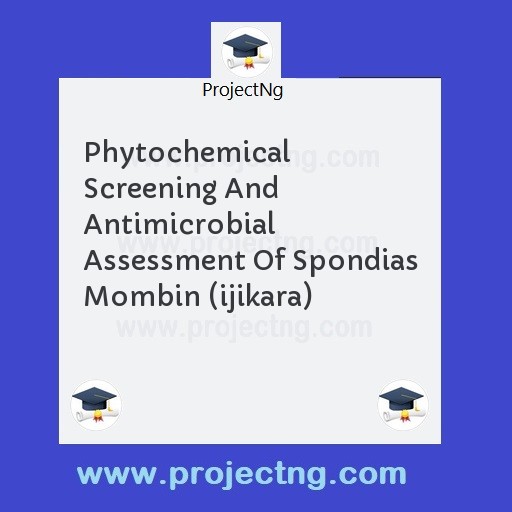Phytochemical Screening And Antimicrobial Assessment Of Spondias Mombin (ijikara)
Science Lab Technology Project Topics
Get the Complete Project Materials Now! »
ABSTRACT
Spondias mombin leaves are popular choices in traditional herbal medicine practice. The present study of the leave extract, therefore, shown the phytochemical constituents, of phenol content and the antioxidant activity of the ethanol leaf extract of Spondias mombin. Results from the phytochemical screening test on S. mombin extract revealed the presence of alkaloids saponnis, anthranoid, phenol and reducing sugars, cardiac glycosides, and tannins. Spondias mombin is a fructiferous tree that belongs to the family Anacardiaceae with about 14 species worldwide. In Nigeria, it is called with several local names, such as (Ijikara).
TABLE OF CONTENTS
Title page i
Approval ii
Dedication iii
Acknowledgement v
Abstract iv
Table of content vi-viii
CHAPTER ONE
1.0 Introduction 1-3
1.1 Scope of study 4
1.2 Statement of the problem 4
CHAPTER TWO
2.0 Literature review 5
2.1 Description of the plant 5
2.2 Classification of the plant 6
2.3 Use of the plant 7-12
CHAPTER THREE
3.0 Materials and methods 13
3.1Collection and processing of the material 13
3.2 Preparation of test organisms 13-14
3.3 Extraction of the plant materials 14-15
3.4 Antimicrobial susceptibility test of the Spondias mombin extracts 15-16
3.5 Tests for minimum inhibitory concentrations
(MIC) of the leaf extracts 16-17
3.6 Test for the bactericidal/fungicidal concentration
of the extract 17-18
3.7 Phytochemical screening of the extracts 18
3.7.1 Test for saponins 18
3.7.2 Test for anthranoid 18
3.7.3 Test for anthroquinone 19
3.7.4 Test for phenol 19
3.7.5 Test for alkaloid 19
3.7.6 Test for tannins 20
3.7.7 Test for phylobatannins 20
3.7.8 Test for cardiac glycoside 20
Table 4.1 Zone diameter of inhibitory of the soxhlet
and aqueous extracts of Spondias mombin
plant extracts 21
Table 4.2: minimum inhibitory concentrations
and minimum bactericidal/fungicidal
concentration (MICS) and MBCS/MFC) of
spondias mombin plant extracts. 22
Table 4.3 Phytochemicals present in Spondias
mombin leaf exracts 23
4.4 Discussion 24-25 CHAPTER FOUR
5.0 Conclusion and recommendation 26
5.1 Conclusion 26
5.2 Recommendation 26
References 27
CHAPTER ONE
1.0 INTRODUCTION
Spondias mombin is a tree, a flowering plant that belongs to the family of Anacardiceae. It is readily common in Nigeria, Brazil and other tropical forests of the world with high genetic variability among pollulations. The plant has been naturised in some parts of the Africa, Indians etc.
It is a fructiferous tree that grows in the coastal areas in the rain forest in a big tree of up to 15-22mm in height. However, the plant is known as Hog plum in English, Akika in Yoruba, Ijikara in Igbo, Isader maser in Hausa, Chabbuli in Fulani and Nsukakara in Efik.
The leaves bark and fruit of the plant have been widely used for both medicinal and non-medicinal purposes, thus the plant has been screened as an unconventional sources of vitamin A and C, and all parts of the tree are ethno pharmacologically importance. A tea of the flowers and leaves is taken to relieve various inflammatory conditions, stomach ache and has wound healing potential (Ayoka and Akomofela, 2008). The tree is commonly used for living fences, in farmlands and shelter by artisans. It has a deciduous, alternate, pinnate leaves (20-45cm long) and harry pinkish, pointed leaflets which are in equilateral and abique at the base. The fruits huaged in numerous branched clusters, are aromatic, ovoid and blong in shape. The wood is used for making huts, garden poles, axe and hoe handles in tropical Africa. It is also popular for carving amults, statuettes, cigarette holders and various ornamental objects.
All parts of the plant are reported to be medicinally useful and its traditional use in reproduction have been reported for example, in peru, decoctions of the bark and or leavers as used as a ‘child birth aid’ (Igwe et al.,2008), the reported use of the plant’s leaf extract as an abortifacient or labour-inducing agent on one hand, and also for prevention of miscarriage in women. Women that are pregnant or those seeking to be pregnant are usually advise against the use of the leaf infusion/ decoction. In South eastern Nigeria, juice extracts from the leaves are used by the native to induce delivery in small ruminant with parturient complications aring from uterine inertia. In Nigeria Spondias mombin are commonly used as local medicinal plants for chewing sticks and for the treatment of dental disease (okwu et al2001), there seen to be paucity of information on the scientific screening of the effect of these local plants on prevention of the dental caries. Then there was a proper reporter in vitro activities of Spondias mombin are commonly used for chewing stick in the south eastern Nigeria on dental caries organism.
Spondias mombin is widely relied on various herbal remedies for numerous conditions and virtually avery part of the tree is used from its thickly corky bark, to its leaves, fruits and even its flower. It has been also reported that the plant extract has antibacterial (Ademola et al., 2005), antiviral antihelmenthic and molluscidal activities.
1.1 SCOPE OF STUDY
This work sought to determine the antimicrobial potency of Spondian mombin (ljikara) against pathogenic organisms such E.coli, Pseudomonas aeruginosa, Staphylococcus aureus, Candida albicans, Spergillus niger.
The tests carried out included antimicrobial sensitivity testing, Minimum Inhibitory Concentration (MlC), Minimum Bactericidal Concentration (MBC) and phytochemical analysis.
1.2 STATEMENT OF PROBLEM
This work is borne out of the fact that certain bacteria and fungi develop resistance to certain synthetic drugs. This research was based on determining if the extract of Spondias mombin will inhibit the growth of certain bacteria and fungi.
Be the First to Share On Social

Enjoying our content?
Don't miss out on new videos! Subscribe to our YouTube channel for more awesome content.
Subscribe Now!













